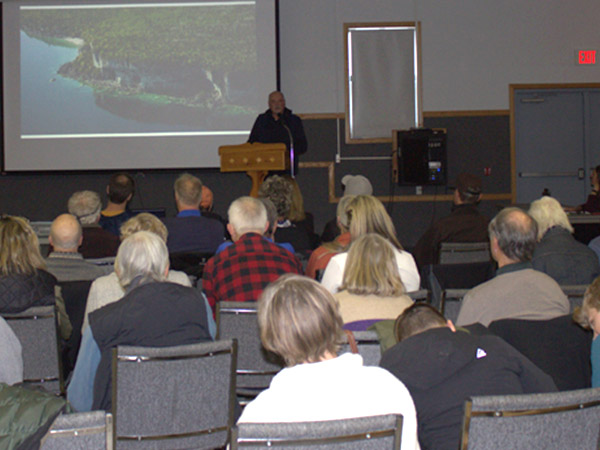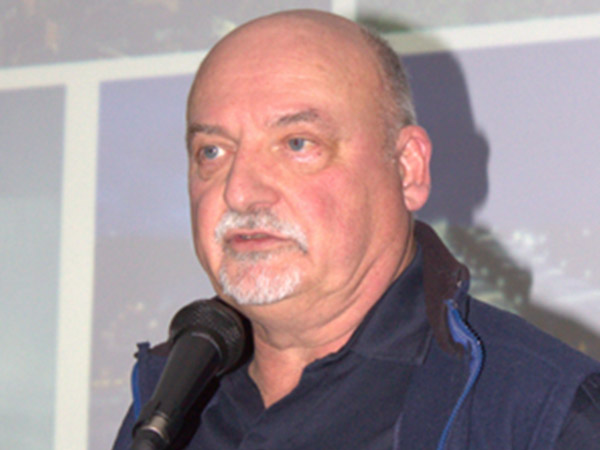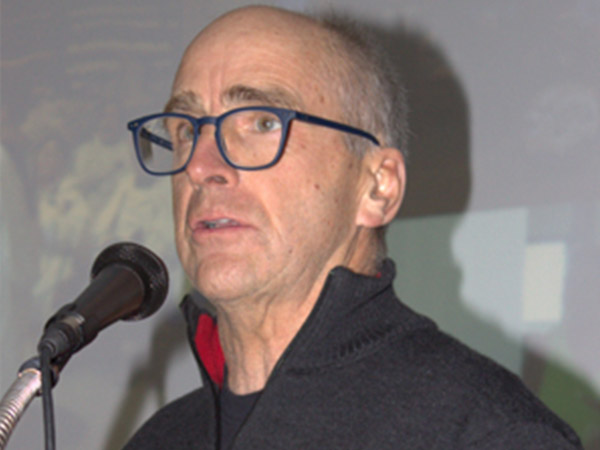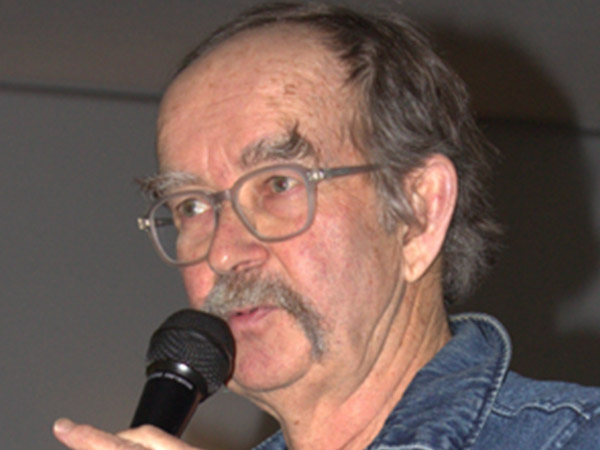in Chatsworth, Grey Highlands, Southgate, West Grey
March 25, 2024

BY KATE RUSSELL — We are all stewards.
According to the theme of the latest public Circle held by the Beaver Valley Destination Stewardship held March 11, 2024 at the Kinplex in Flesherton, everyone has a role to play in caring for the planet.
The local volunteer-run group drew over 100 people earlier this month to hear updates on environmental protection and tourism developments in the region. Folks were able to attend the information session in-person and online.
Acknowledging the traditional territories of the land, the Circle’s main topic was the Aspiring Georgian Bay Geopark, a grassroots initiative fostering Indigenous-informed responsible tourism and other activities across all Georgian Bay through research and education on the ongoing impact on the region’s unique geology.

But first, Norm Ragetlie, Co-Chair of the Niagara Escarpment Biosphere Network (NEBN) spoke. He updated those in attendance on to the recent periodic review report prepared for the Canadian Commission for UNESCO. That submission will hopefully maintain the escarpment’s special recognition for its biodiversity, and as a natural wilderness corridor.
He explained the NEBN was formed when a previous such report, submitted by the Niagara Escarpment Commission, garnered UNESCO feedback, suggesting a single government agency doesn’t represent the public, which should have “shared responsibility”. UNESCO also noted the escarpment lands require more Indigenous engagement.
“The NEC concluded it needed to get out of the way,” Ragetlie explained, adding the NEBN was then founded in 2019. Picked for the transition team, he admitted the timing wasn’t great as COVID prevented engagement. But starting with Indigenous communities, they formed a co-ownership model with Indigenous-led Plenty Canada to explore Two-Eyed Seeing and Ethical Space training. “We do believe our model is part of what we bring to the table.”
In that model, Ragetlie co-chairs with Indigenous elder Charlene Winger-Jones, a Hereditary Council member, Water Walker and Climate Reality Leader from Neyaashiinigmiing (formerly Cape Croker). He offered the NEBN are not “doers”, but serve in the role of transferring knowledge. This includes the research and monitoring in the recent report as well as Indigenous wisdom. Thus, seeing through two eyes – of science and Indigenous knowledge.
“Our philosophy is there’s a lot of organizations doing great work,” he said, meaning the many volunteers on the ground maintaining trails, caring for rivers, doing clean up and stewardship work as well as First Nations sharing knowledge, such as through the annual Sources of Knowledge Forum coming up in May on the Saugeen Peninsula. “We need to transfer the learnings up and down the escarpment. We’re on this journey together, we’ll get further going together.”
His prelude to Mike Robbins presenting on the Aspiring Georgian Bay Geopark was appropriate as the Indigenous connection is underway there as well. It has paused, sadly, with the loss of Jack Contin last November. A proud Ojibway who reconnected to his heritage as he navigated the challenges of the Sixties Scoop, Contin’s obituary tells how he “believed in the power of collective action and worked tirelessly to make a positive impact on the world around him.”
As a dedicated supporter of the project, he provided a protocol for Indigenous engagement to the Aspiring Georgian Bay Geopark, which is still being followed as the group seeks to deepen understandings with Indigenous peoples all around the bay.
Contin’s philosophy is based on the Dish with One Spoon principle, where the dish represents land, and the aspiration for land use and water shared peacefully and beneficially for all and the spoon signifies people coming together to uphold the vision of a lasting relationship to share and care for the land and water. The Geopark also references the Seven Grandfather teachings, invoking a spirit of cooperation to work together through love, respect, bravery, truth, honesty, humility and wisdom.

Robbins spoke of his passion and expertise in working with Indigenous groups, who he noted “fully understand responsible or fully-sustainable tourism.” He said Geoparks are not traditional parks, have no legal protection but are based on education and research more than legislation.
“It has to be community driven,” Robbins explained, suggesting there is opportunity to explore eight “chapters” of stories around the bay. The idea of “exploring deep time for a sustainable future,” is guiding the work in watersheds around Georgian Bay, which he said played a huge role in shaping this country.
“It was Canada’s first highway for Indigenous, fur trade, settler economy,” he said, adding with its largest freshwater island (Manitoulin) and the longest freshwater beach (Wasaga) and more, the bay area is geologically, “really globally significant.”
He reviewed the many perspectives on the project, geo tourism sites, Indigenous mapping opportunities and immersive storytelling. There are 41 First Nations and five Metis Councils around the bay who stand to see significant need met with opportunity for economic development around sustainable tourism in unrealized domestic and international markets.
“Efforts for responsible tourism should focus on what is unique,” Robbins offered, from his years of tourism development experience. He said foundations for opportunities exist in Geotourism, Indigenous-led tourism, destination stewardship and Geofoods and products from the local area. “The wellbeing of local residents needs to be first and foremost as we develop tourism.”
He concluded with the idea Aspiring Georgian Bay Geopark visitors would come from “higher yield and more sensitive markets,” of people who are more affluent and have sincere interest. “There’s a large and growing market that really fits the characteristics people want to attract. We get protection through education, research and enhanced knowledge. That’s the way we’re going to protect Georgian Bay.”

Next to the podium, or rather to the slide show, was local author and historian Robert Burcher, who offered his “White man’s view” of Indigenous history in the area. The Beaver River watershed has been inhabited by people for 12,000 years. From the Paleo and Archaic through Woodland and Contact periods used by archaeologists to date sites and artifacts, Burcher took the audience on a brief tour of local Indigenous habitation.
“Where I live in Slabtown is a paleo site,” he suggested, noting it matches early shorelines on what was a large body of water in the valley, he calls Lake Kimberley. “I’m interested in the gifts of history the land has given to us.”
While he had a map of sites, he was not specific about any locations. This is especially true of landscapes where chert is easily accessible. Used to make tools and points, chert artifacts are one of the indicators of early Indigenous people in the area.
He spoke to the various early Nations on the land, suggesting the Petun were the last of the Hurons to inhabit the area. He told a story of Iroquois attacks in the 1640s and the subsequent migration of the surviving Petun away to join other tribes to become the Wyandot in Oklahoma.
“That was the end of the presence of Natives in Beaver Valley,” he said, offering the tales told at Scenic Caves have kept some of the old stories in front of visitors to the place. He did not offer up other spots of discovery, as “everybody’s afraid of looting.”
Beaver Valley Destination Stewardship volunteer Stacie Howe wrapped up the evening, saying, “the beautiful Beaver Valley is globally significant.” She thanked the presenters for the important work they are doing and those attending the Circle for their interest and dedication. “We have an incredible role to play on these lands that have been people’s homes for thousands of years.”
She stressed the destination stewardship group is learning two-eyed seeing — a way of understanding Indigenous perspective, which is “not data driven, it’s story driven, heart driven – a way of connecting with the people who lived here.” This is added to the archaeological perspective that uses “data but shows stories have a history.” By knowing both sides, “we can see through both ways.”
Attendees had the chance to ask questions and connect with each other after the presentations. It was a lot of knowledge to share in one evening, so the BVDS looks forward to more learning and sharing information in the future. To stay in touch, follow the group on Instagram or find them on Linked In or join the conversation on Hylo.
At South Grey News, we endeavour to bring you truthful and factual, up-to-date local community news in a quick and easy-to-digest format that’s free of political bias. We believe this service is more important today than ever before, as social media has given rise to misinformation, largely unchecked by big corporations who put profits ahead of their responsibilities.
South Grey News does not have the resources of a big corporation. We are a small, locally owned-and-operated organization. Research, analysis and physical attendance at public meetings and community events requires considerable effort. But contributions from readers and advertisers, however big or small, go a long way to helping us deliver positive, open and honest journalism for this community.
Please consider supporting South Grey News with a donation in lieu of a subscription fee and let us know that our efforts are appreciated. Thank you.